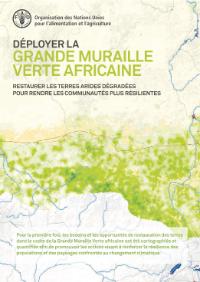Governing Grazing and Mobility in the Samburu Lowlands, Kenya
Pastoral mobility is seen as the most effective strategy to make use of constantly shifting resources. However, mobile pastoralism as a highly-valued strategy to manage grazing areas and exploit resource variability is becoming more complex, due to recurrent droughts, loss of forage, government-led settlement schemes, and enclosure of land for community conservation, among other reasons. Yet knowledge of how Samburu pastoralists perceive these changes, and govern and innovate in their mobility patterns and resource use, has received limited attention.
Rangeland Livelihood Strategies under Varying Climate Regimes: Model Insights from Southern Kenya
Rangelands throughout sub-Saharan Africa are currently undergoing two major pressures: climate change (through altered rainfall and seasonality patterns) and habitat fragmentation (brought by land use change driven by land demand for agriculture and conservation). Here we explore these dimensions, investigating the impact of land use change decisions, by pastoralists in southern Kenya rangelands, on human well-being and animal densities using an agent-based model.
Pastoral Resilience among the Maasai Pastoralists of Laikipia County, Kenya
This paper addresses pastoral resilience by drawing out the coping strategies and mechanisms utilized by the Maasai Pastoralists through a food system approach, based on the study findings of an anthropological study of pastoralism as a food system in Laikipia County, Rift Valley, Kenya. The co-existence and interactions of pastoralism as a food system with other types of food systems in Laikipia, such as large-scale horticulture, justified the selection of the study site.
Kenya Accelerated Value Chain Development Program (AVCD)—livestock component: Policy dialogue: Accelerating county spatial planning in rangelands
Livestock-derived greenhouse gas emissions in a diversified grazing system in the endangered Pampa biome, Southern Brazil
Discussions about climate change have repeatedly regarded livestock as responsible for a significant contribution of greenhouse gas emissions. However, proper management schemes for livestock production may contribute to a reduction in emissions and, at the same time, induce optimization of production systems and intensification of food production.
Déployer la Grande Muraille Verte africaine
Pour la première fois, les besoins et les opportunités de restauration des terres dans le cadre de la Grande Muraille Verte africaine ont été cartographiés et quantifiés afin de promouvoir les actions visant à renforcer la résilience des populations et de ces paysages confrontés au changement climatique.
La transhumance transfrontalière du bétail
La transhumance transfrontalière est trop souvent réduite à une activité génératrice de conflits qu’il est possible de régler très facilement en fermant les frontières. Cette note aux décideurs montre une réalité beaucoup plus complexe. La mobilité pastorale en Afrique de l’Ouest représente un apport économique de plusieurs dizaines de milliards de Fcfa chaque année dans toutes les zones d’accueil. Dans une région troublée sur le plan sécuritaire et confrontée au défi de l’emploi et de la pauvreté, la dimension économique, sociale et politique de la transhumance est importante à préserver.
Community-based rangeland management in Shompole and Olkiramatian group ranches, Kenya: Taking successes in land restoration to scale project
Bodyweight performance, estimated carcass traits and methane emissions of beef-cattle categories grazing Andropogon gayanus, Melinis minutiflora and Stylosanthes capitata mixed swards and Brachiaria humidicola pasture
Models meet data: Challenges and opportunities in implementing land management in Earth system models
As the applications of Earth system models (ESMs) move from general climate projections toward questions of mitigation and adaptation, the inclusion of land management practices in these models becomes crucial. We carried out a survey among modeling groups to show an evolution from models able only to deal with land-cover change to more sophisticated approaches that allow also for the partial integration of land management changes. For the longer term a comprehensive land management representation can be anticipated for all major models.
Operationalizing payments for ecosystem services for pastoralists in rangeland settings
Payments for ecosystem services (PES) schemes are gaining popularity as an environmental and development policy tool. Spurred by environmental motives, different financial and non-financial incentive schemes are designed to create positive social and environmental impact. Although the experience of PES implementation is relatively significant in the agricultural, forestry and to a certain degree marine sector, the application of PES for pastoralists in rangeland settings is limited.





